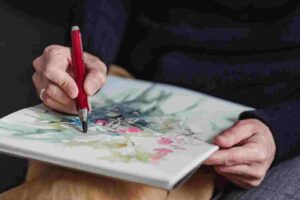Journaling is a powerful tool that allows you to unlock the magic of self-expression, gain clarity, and tap into your creativity. Writing down your thoughts, feelings, and experiences in a personal journal is a process. This practice has been around for centuries, with famous figures like Leonardo da Vinci, Anne Frank, and Frida Kahlo using journals to document their lives and innermost thoughts. Whether you’re a seasoned writer or new to the world of journaling, this article will guide you on how to journal effectively and make the most out of this transformative practice.
Benefits of Journaling
Journaling offers a wide range of benefits that can positively impact your life. Firstly, it provides a safe space for self-expression. In a journal, you can freely express your thoughts and emotions without fear of judgment or reprisal. This can be incredibly liberating and allows you to explore your innermost thoughts and feelings honestly.
Secondly, journaling promotes self-expression and personal growth. By recording your experiences, you can gain valuable insights into your own life. Journaling helps you explore patterns, identify triggers, and understand your reactions to situations. It serves as a powerful tool for self-awareness and self-improvement.
Additionally, journaling can boost your creativity and inspiration. By regularly engaging in the practice, you stimulate your imagination and tap into your creative potential. Many writers, artists, and musicians use journaling to generate ideas, explore new perspectives, and capture fleeting moments of inspiration.
Different Types of Journaling

Journaling is a versatile practice for self-expression that can take many forms. Here are a few different types of journaling you can explore:
- Stream-of-Consciousness Journaling: This type involves writing continuously without filtering or editing your thoughts. It lets you release your innermost thoughts and emotions onto the page, providing a cathartic release.
- Gratitude Journaling: In a gratitude journal, you write down things you are grateful for daily. This practice cultivates a mindset of appreciation and can shift your focus to the positive aspects of your life.
- Dream Journaling: Dreams can hold valuable insights and symbolism. Keeping a dream journal allows you to record your dreams upon waking, helping you explore their meanings and uncover hidden messages from your subconscious.
- Travel Journaling: If you enjoy exploring new places and cultures, a travel journal is a fantastic way to document your adventures. You can capture your experiences, thoughts, and observations, creating a beautiful keepsake of your journeys.
How to Start Journaling for Self-Expression
Starting a journaling practice is simple; you only need a pen and paper or a digital device. Here’s how to get started:
- Choose your medium: Decide whether you prefer writing on paper or using a digital platform. Both options have advantages, so choose the one that feels most comfortable.
- Set aside dedicated time: Carve out a specific time in your day for journaling. It could be in the morning, before bed, or during a quiet moment in the afternoon. Consistency is critical, so try to make it a daily practice.
- Create a welcoming space: Find a cosy and quiet spot to journal without distractions. Make it inviting by adding candles, soft lighting, or calming music to create a peaceful atmosphere.
- Start writing: Begin by writing freely about anything that comes to mind. Don’t worry about grammar, spelling, or structure. Let your thoughts flow naturally onto the page.
- Experiment with prompts: If you’re unsure where to start, use journaling prompts to guide your writing. Prompts can be in the form of questions, quotes, or specific topics that inspire reflection.
Setting up a Journaling Routine for Self-Expression
To make the most out of your journaling practice, it’s essential to establish a routine. Here are a few tips to help you set up a consistent journaling habit:
- Choose a regular time: Select a time of day that works best for you and stick to it. Whether in the morning to set intentions for the day or in the evening to reflect on your experiences, find a time that aligns with your schedule.
- Keep your journal nearby: Have your journal and writing tools easily accessible. This way, you can seize any opportunity to write, even for a few minutes during a lunch break or while waiting for an appointment.
- Set intentions: Before you start writing, take a moment to set an intention for your journaling session. It could be to gain clarity on a specific issue, explore a particular emotion, or let your thoughts flow freely. This intention will guide your writing and focus your mind.
- Be consistent: Consistency is critical in building a journaling routine. Aim to write every day, even if it’s just for a few minutes. Over time, this regular practice will become a valuable habit.
Prompts and Exercises for Journaling

Sometimes, having specific prompts or exercises to stimulate your journaling practice can be helpful. Here are a few ideas to get you started:
- Write a letter to your past self: Reflect on your journey and offer wisdom and encouragement to your younger self.
- Describe your perfect day: Imagine your perfect day from start to finish. Write down all the details, capturing the sights, sounds, and emotions.
- Explore your fears: Journaling can be a safe space to confront and explore your concerns. Write about your deepest fears and consider ways to overcome them.
- List your accomplishments: Take a moment to celebrate your achievements, big and small. Write down a list of things you’re proud of and use them as a reminder of your strengths.
Journaling for Self-Reflection and Personal Growth
One of the most potent aspects of journaling is its ability to facilitate self-reflection and personal growth. By regularly journaling, you create a space for introspection and self-awareness. Here’s how journaling can support your personal growth:
- Identifying patterns: As you write about your experiences, you may start noticing patterns in your thoughts, emotions, and behaviors. These patterns can provide valuable insights into recurring themes in your life and help you identify areas for personal growth.
- Processing emotions: Journaling allows you to process and healthily release emotions. You gain clarity and understanding of your emotional landscape by putting your feelings into words. This process promotes emotional well-being and can lead to greater emotional intelligence.
- Setting goals: Writing down your goals and aspirations is an effective way for self-expression and manifest them into reality. Journaling can help you clarify your desires, break them into actionable steps, and track your progress.
- Cultivating gratitude and positivity: Practicing gratitude through journaling can shift your focus to the positive aspects of your life. By regularly recording moments of gratitude, you develop a mindset of appreciation and attract more positivity into your life.
Journaling for Creativity and Inspiration

Journaling is a tool for self-expression and a powerful catalyst for creativity and inspiration. Here’s how journaling can enhance your creative endeavours:
- Capturing ideas: Your journal can be a treasure trove of ideas and self-expression. Use it to jot down creative thoughts, story concepts, or artistic inspirations that come to you throughout the day. When you’re feeling stuck, revisit your journal for inspiration.
- Exploring new perspectives: Writing in your journal allows you to explore different perspectives and gain fresh insights. Try writing from the point of view of someone else, a fictional character, or even an inanimate object. This exercise can spark creativity and help you see things from a new angle.
- Free-writing: Set a timer for a few minutes and let your pen flow freely. Write without judgment or self-editing. Free writing can unlock self-expression and tap into your subconscious, revealing hidden thoughts and ideas.
- Visual journaling: Don’t limit yourself to just words. Incorporate visual elements for better self-expression into your journal, such as sketches, doodles, or collages. Visual journaling can ignite your creativity and visually represent your thoughts and emotions.
Journaling for Stress Relief and Mental Well-being
Stress and overwhelm can affect our mental well-being in today’s fast-paced world. Journaling offers a therapeutic outlet for managing stress and promoting mental health. Here’s how journaling can help:
- Emotional release: Writing about your thoughts and emotions can provide a cathartic release, letting you let go of pent-up feelings and stress. This emotional release can lead to a sense of relief and relaxation.
- Problem-solving: Self-expression through journaling can help you gain clarity and perspective on challenging situations. By writing about a problem or dilemma, you can analyze it objectively and explore potential solutions. This process can alleviate stress and empower you to make informed decisions.
- Self-care ritual: Engaging in self-expression through regular journaling can become a soothing self-care ritual. Carving out time for yourself, away from the demands of daily life, allows you to relax, reflect, and recharge.
- Gratitude practice: By incorporating gratitude into your journaling routine, you shift your focus to the positive aspects of your life. Self-expression of gratitude has been scientifically proven to reduce stress, increase happiness, and improve overall well-being.
Resources and Tools for Journaling

If you’re looking to enhance your journaling experience, there are several resources and tools available to support you:
- Pen and paper: The classic combination of pen and writing provides a tactile and intimate journaling experience. Choose a journal that resonates with you and a pen that feels comfortable.
- Digital journaling apps: If you prefer a digital approach, numerous journaling apps are available for smartphones and tablets. These apps often come with additional features like reminders, prompts, and the ability to attach photos or voice recordings.
- Journaling courses and workshops: Consider enrolling in a journaling course or attending a workshop to deepen your practice. These resources can provide guidance, inspiration, and a supportive community of fellow journalers.
- Books on journaling: Explore the vast array of books on journaling to gain new insights and inspiration. From guided journals to books on specific journaling techniques, there is something for every level of journaling experience.
Conclusion: The Magic of Self-Expression

Journaling is a transformative practice that opens the door to self-expression, clarity, and creativity. By incorporating journaling into your daily routine, you can unlock the magic within yourself. Whether you’re seeking personal growth, stress relief, or a way to tap into your creative potential, journaling offers a powerful tool to support your journey. So grab your pen and paper, open your favourite digital journaling app, and embark on this beautiful adventure of self-discovery and self-expression.
Take the first step on your journaling journey today and discover the magic of self-expression.